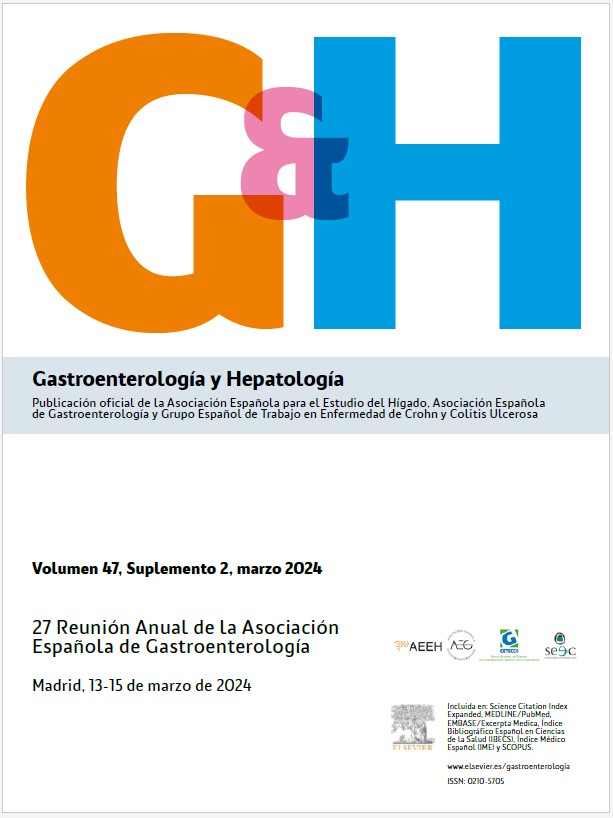P-59 - EFFECT OF THE HLA-DQA1*05 ALLELE ON THE EFFICACY OF USTEKINUMAB IN PATIENTS WITH CROHN'S DISEASE. MULTICENTER STUDY BASED ON THE ENEIDA REGISTRY OF GETECCU
1Hospital Universitari de Bellvitge, Gastroenterologia, Hospitalet de Llobregat. 2Hospital Universitario y Politécnico La Fe, Valencia. 3Hospital Clínic de Barcelona. 4Hospital Ramón y Cajal, Madrid. 5Hospital Santa Creu i Sant Pau, Barcelona. 6Hospital Clínico Universitario de Santiago de Compostela. 7Hospital Clínico Universitario de Valencia. 8Hospital Universitario Marqués de Valdecilla, Santander. 9Hospital Mutua de Terrassa. 10Hospital Universitario de Burgos. 11Complejo Asistencial Universitario de León. 12Corporació Sanitaria Parc Taulí de Sabadell. 13Hospital de Manises. 14Hospital Universitario Reina Sofía, Córdoba. 15Hospital Parc de Salut Mar, Barcelona. 16Hospital Universitario La Paz, Madrid. 17Hospital Central de Asturias, Oviedo. 18Hospital Germans Trias i Pujol, Badalona. 19Hospital General de Alicante. 20Hospital Miguel Servet, Zaragoza. 21Hospital Universitari de Bellvitge, Genética molecular Laboratori clínic, Hospitalet de Llobregat. 22Hospital Marques de Valdecilla, Santander.
Introduction: HLA-DQA1*05 carriage is associated with the development of anti-drug antibodies and loss of response (LOR) to tumor necrosis factor antagonists (anti-TNF) in patients with inflammatory bowel diseases (IBD) (Sazonovs et al. Gastroenterology 2020). Ustekinumab has shown very low rates of immunogenicity and presumably will not be affected by this risk. Identifying patients at high risk of treatment failure would be important when selecting therapy for IBD.
Objectives: AIM: The objective of this analysis was to investigate the relationship between the HLA- QA1*05 allele and ustekinumab on development of LOR and drug persistency.
Methods: This is a retrospective cohort study from a prospectively maintained ENEIDA registry. LOR was defined as recurrence or worsening of IBD related symptoms that required a change or intensification in treatment, hospitalization or surgery. Independent predictors of LOR were identified using univariate and multivariable Cox proportional hazard regression. The HLA-DQA1*05 allele was determined from a saliva sample (kit OGD-600 de DNA Genotek Oragene) and DNA extraction with the Maxwell® RSC-Stabilized Saliva DNA kits.
Results: 204 patients with Crohn's disease were included. Previous exposure to biological drugs was 96% (61% ≥ 2 biological drugs). Basal fecal calprotectin levels were 907 ± 970 μg/g and PCR levels 16.2 ± 25 mg/dL. The median follow-up was 417 ± 154 days. During this period, 25%, 16% and 13% of the patients required drug intensification, hospitalization or surgery, respectively. 43% of the patients included were carriers of one or two copies of the HLA-DQA1*05 allele. The presence/absence of this allele was not associated with LOR to ustekinumab (20 vs. 16%, p = ns) nor with drug withdrawal (11 vs. 6%, p = ns). In the multivariate analysis (Cox regression), only the number of previous biological drugs was associated with ustekinumab persistency.
Conclusions: The presence of the HLA-DQA1*05 allele is not related to LOR or persistency of ustekinumab treatment. First-line treatment with ustekinumab rather than anti-TNF agents may be considered in HLA-DQA1*05-positive patients, particularly when the use of a concomitant immunosuppressant is contraindicated.









